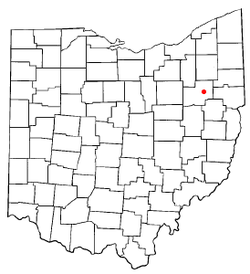Louisville, Ohio
| Louisville, Ohio | |
|---|---|
| City | |

St. Louis Church, built 1870
|
|
| Nickname(s): "The Constitution Town" | |
 Location of Louisville, Ohio |
|
 Location of Louisville in Stark County |
|
| Coordinates: 40°50′14″N 81°15′33″W / 40.83722°N 81.25917°WCoordinates: 40°50′14″N 81°15′33″W / 40.83722°N 81.25917°W | |
| Country | United States |
| State | Ohio |
| County | Stark |
| Government | |
| • Mayor | Patricia A. ("Pat") Fallot |
| Area | |
| • Total | 5.49 sq mi (14.22 km2) |
| • Land | 5.49 sq mi (14.22 km2) |
| • Water | 0 sq mi (0 km2) |
| Elevation | 1,142 ft (348 m) |
| Population (2010) | |
| • Total | 9,186 |
| • Estimate (2012) | 9,152 |
| • Density | 1,673.2/sq mi (646.0/km2) |
| Time zone | Eastern (EST) (UTC−5) |
| • Summer (DST) | EDT (UTC−4) |
| ZIP code | 44641 |
| Area code | 330 |
| FIPS code | 39-45094 |
| GNIS feature ID | 1061447 |
Louisville (pronounced LEWIS-ville) is a city in Stark County in the U.S. state of Ohio. The population was 9,186 at the 2010 census. It is part of the Canton-Massillon, OH Metropolitan Statistical Area.
On October 8, 1834, Louisville was formally settled by Henry Lautzenheiser, from Germany, and Henry Fainot, a French Huguenot. The city was named after Lautzenheiser's son, Lewis, and called Lewisville, Ohio. The name of the town was also considered appropriate because of the fact that it was initially surveyed by the similar-sounding name of Lewis Vail. When the post office was established in 1837, with Sam Petree as its first postmaster, it was discovered Ohio already had a Lewisville, so the spelling was changed to Louisville.
Within Louisville's early days, the town competed with the fellow Nimishillen Township community of Harrisburg for growth. Harrisburg initially flourished due to its accessibility as a stagecoach stop between Canton, Alliance, Cleveland, and Pittsburgh. Meanwhile, Louisville also grew, due to its location upon the east branch of the Nimishillen Creek, which flows toward Canton. However, when the Pittsburgh, Fort Wayne and Chicago Railway was laid through Louisville in 1852, Louisville began to grow more quickly than Harrisburg, which struggled with the difficulty of hauling its main product, wheat, by barge. Today, Harrisburg is now an unincorporated community, marked only by a handful of businesses and a Roman Catholic parish.
On April 1, 1872, Louisville was officially incorporated as a village, with George Violand elected as Louisville's first mayor. By the late 19th Century, Louisville contained many quickly growing businesses, including: a plow manufacturing company, a wooden mill, a brewery, a basket factory, flour mills, tanneries, a brick yard, two hotels, a shoe factory, and a number of taverns/saloons (Louisville had twenty saloons at one point, giving the town a rather notorious reputation). Three of these businesses, Star Mill, Town Tavern, and the Mainstay Bed & Breakfast, remain open to this day. Furthermore, many of the buildings constructed within Louisville during this time period are listed upon the National Register of Historic Places. Such locations include Saint Louis Catholic Church, which was completed in 1870 and dedicated in 1878, and the city's historic downtown district, roughly bordered by Chapel Street, Lincoln Court, St. Louis Court, Nickelplate Street, East Gorgas Street, and Center Court. The city's current weekly newspaper, The Louisville Herald, was first published in 1887. For a brief time, the town also had a Roman Catholic college, established by the Reverend Louis Hoffer, located across the street from St. Louis Church. Called Saint Louis College, it opened in 1866 under the operation of the Diocese of Cleveland. The Congregation of St. Basil of Toronto assumed control of the college the following year, and Saint Louis College closed in 1873, due to lack of funds and transportation difficulties for the students. After briefly serving as an all-girls academy and a school for deaf mutes, The building became an orphanage under the guidance of the Vincentian Sisters of Charity. The Saint Louis Orphan Asylum closed in 1925, and became a hospice for the elderly, named St. Joseph's, in 1927. The old red brick building was razed in 1975, as St. Joseph's moved across the street from St. Thomas Aquinas High School. A McDonald's is now located upon the site.
...
Wikipedia
